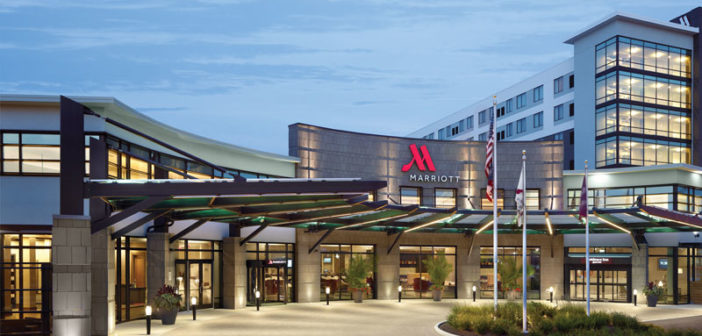COLUMBUS, OH—Driven by OSU and the state capital, the city’s economy is fairly healthy, and so is the hotel market within the city’s borders. RevPAR and ADR are expected to increase by year-end 2018. On the decline is occupancy. All in all, the city’s hotel market is expected to grow next year—mainly due to the city’s resurgence.
“The Central Ohio hotel market is best described as stable, with a steady trajectory,” said Mark Eble, managing director of CBRE Hotels’ Consulting’s Midwest practice. “The city has experienced supply and demand growth in all submarkets.”
By year-end 2018, Columbus hotels are forecast to see a RevPAR increase of 1.1%, according to CBRE’s Q2 2018 data. Occupancy is expected to decline by 0.5% during the same time period. In 2018, ADR is projected to grow by 1.6%; supply is expected to grow by 3.8%; and demand is forecast to gain by 3.3%.
“In Columbus, the supply growth is distributed heavily in the upper-priced segments, but is also occurring in the lower-priced segments,” he said.
Properties in the upper-priced segment of the city are expected to experience an ADR growth rate of 0.1%; a 0.9% loss in occupancy; and a 0.7% decrease in RevPAR. Supply in the segment is projected to grow by 6.6%. Demand is expected to increase by 5.7%.
In the lower-priced segment, properties are expected to witness a 2.3% increase in ADR; a 0.4% decline in occupancy; and a 1.9% increase in RevPAR. Supply in the segment is projected to grow by 2.0%. Demand is expected to increase by 1.5%.
In Ohio’s state capital, the top upper-priced brands include Courtyard, Hilton, Crowne Plaza, Marriott and Embassy Suites; top lower-priced brands in the Central Ohio region include Red Roof Inn, Motel 6, Extended Stay America, Days Inn and Fairfield Inn. The total room supply in Columbus is 28,575 rooms, according to CBRE’s Q2 2018 numbers.
“Columbus is diverse, healthy and robust,” Eble said. “The stabilizing economic presence of OSU and the state capital are primary drivers. Columbus is a top-25 city and also attractive to institutional owners. Competition for assets is not as intense as in top 10 and gateway cities. Rates of return are generally better, with a stable and healthy environment.”
“Recent transaction volume is steady,” said Christopher Diffley, managing director of investments development at Rockbridge. “Activity over the last three to five years has picked up. The market has seen/is seeing an influx of new, high-quality hotels to accommodate the attractive broad base of demand and a trend of growth into the future. With a deepening supply of high-quality, institutional assets coupled with attractive market fundamentals, the market could see an increase in transaction volume in the near-term.”
There are at least 20 Fortune 1000 companies in the city. “Columbus/Central Ohio benefits from a diverse demand base—state capital and university functions have historically anchored the market,” said Adam Valente, president of Continental Hospitality Group, a Columbus, OH-based hotel management company. “But, over time, Central Ohio has become a stronger convention and corporate market. The job market has always been strong, led by a handful of large companies.” Some of these Fortune 1000 entities include Cardinal Health, Nationwide Insurance, AEP, Battelle, Ohio Health, Grange Insurance and Huntington Bancshares. Firms such as NetJets, Chase, Kroger and Anheuser-Busch also have major facilities in Central Ohio.
“The market stability is provided by a diverse foundation of employment, including the state capital, OSU, financial services, transportation and healthcare,” Eble said. “As hotel demand generators, this diversification makes the market desirable for both destination and investment dollars.”
For tourists, the city offers the Schottenstein Center, OSU sports, cultural events and breweries. “Visiting Columbus takes more than one day,” he said. “There’s also the Ohio State Fair, the Arnold Fitness Classic, the Columbus Zoo and the aquarium to consider.”
Some of the latest property openings in Central Ohio include Hotel LeVeque, a 149-room property located in the iconic Leveque Tower; the dual-branded, 354-room Marriott Hotel and Residence Inn property; AC Hotel Columbus Dublin, a 150-room property part of a mixed-use development known as Bridge Park West; and the 214-key Renaissance Columbus Downtown Hotel.
“More than 1,000 rooms have been opened in 2018, located in 10 hotels,” Eble said. “All but one were suburban. The only CBD hotel to open in 2018 is the 105-room Home2, near Grant Hospital and Children’s Hospital.”
The city’s supply pipeline consists of 42 properties with 4,353 rooms. There are 11 upper-priced properties with 1,477 rooms; 29 lower-priced properties with 2,671 rooms; and two independent properties with 205 rooms, according to CBRE’s Q2 2018 numbers.
“There is attractive risk-adjusted return potential owning hotels in Columbus,” Valente said. “It is a relatively safe place to invest as it has historically stayed out of harm’s way—the market isn’t overweight in one sector or another, it isn’t in the direct path of natural disasters, there is a favorable business climate, there’s generally a rational political climate and Ohio State University is a proverbial factory of hotel demand and an educated workforce of recent grads who want to stay in Columbus. This collective makes for good prospects of success for hotel owners.”
The majority of the notable properties in Columbus’ pipeline can be found in the city’s CBD. The following properties are expected to be completed within the next two years: a 167-room Canopy by Hilton, set to open in 2019; a 111-room Moxy by Marriott, slated to open in 2019; a 163-room AC Hotel, scheduled to open in 2019; Hilton’s expansion at the convention center, expected to open in 2021; a 171-room Graduate Hotel; and a 130-room Residence Inn by Marriott, expected to open in 2019.
“The durability of the economic recovery in general has been extended by healthy employment growth and low interest rates,” Eble said. “The hotel industry specifically has benefited from a long runway of improved metrics, improving operating efficiency, and a generally disciplined lending environment. We anticipate that for many reasons that Ohio and the Midwest will continue its persistence of modest gains.”
Columbus RevPAR is expected to grow 1.6% in 2019, according to CBRE’s Q2 2018 data. Occupancy is projected to grow by 0.3%; ADR is expected to grow by 1.3%. In 2019, supply is projected to increase by 2.9%; demand is expected to attain a 3.2% gain.
“Columbus is poised for continued growth,” Eble said. “The core of the city is experiencing a tremendous resurgence, largely driven by residential desirability. Living options in downtown are expanding, as the OSU/CBD/German Village corridor experiences improved linkage. The Franklinton area is also maturing, offering additional options. The convenience of residential to CBD employment, and growing support services, are transforming the dynamics of the entire city. The Arena District boasts the recently expanded convention center. The healthy city core has radiated to suburban locations as well. Significant growth in all submarkets is being experienced.” HB


